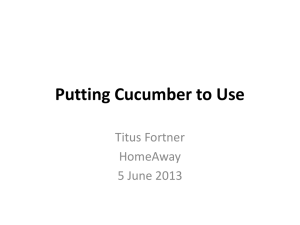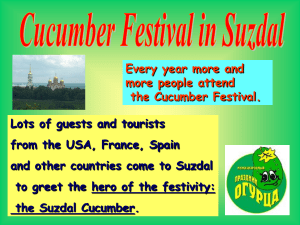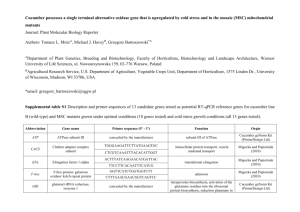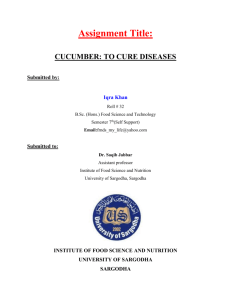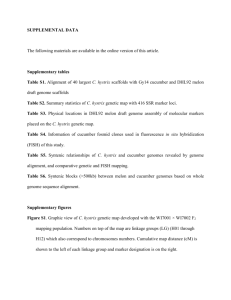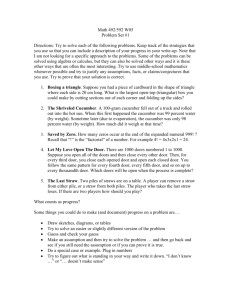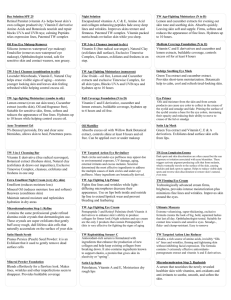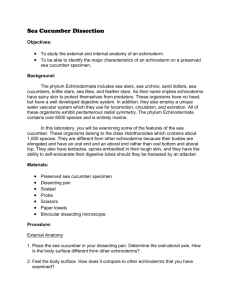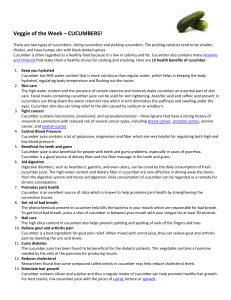the full article here - E-International Scientific Research
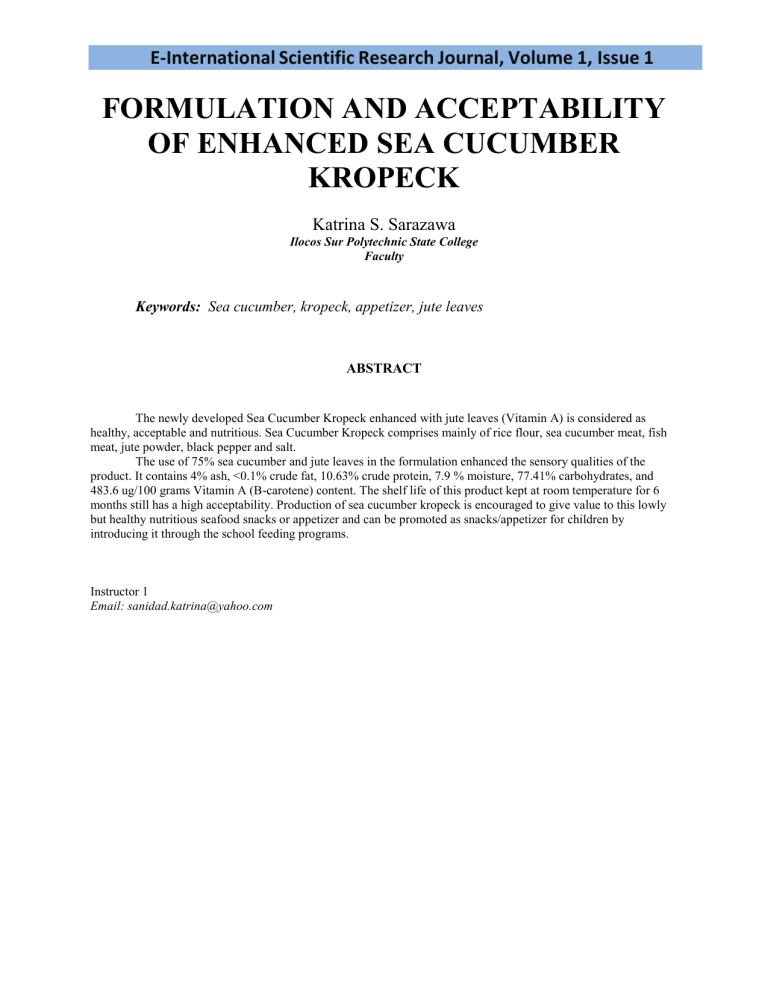
E-International Scientific Research Journal, Volume 1, Issue 1
FORMULATION AND ACCEPTABILITY
OF ENHANCED SEA CUCUMBER
KROPECK
Katrina S. Sarazawa
Ilocos Sur Polytechnic State College
Faculty
Keywords: Sea cucumber, kropeck, appetizer, jute leaves
ABSTRACT
The newly developed Sea Cucumber Kropeck enhanced with jute leaves (Vitamin A) is considered as healthy, acceptable and nutritious. Sea Cucumber Kropeck comprises mainly of rice flour, sea cucumber meat, fish meat, jute powder, black pepper and salt.
The use of 75% sea cucumber and jute leaves in the formulation enhanced the sensory qualities of the product. It contains 4% ash, <0.1% crude fat, 10.63% crude protein, 7.9 % moisture, 77.41% carbohydrates, and
483.6 ug/100 grams Vitamin A (B-carotene) content. The shelf life of this product kept at room temperature for 6 months still has a high acceptability. Production of sea cucumber kropeck is encouraged to give value to this lowly but healthy nutritious seafood snacks or appetizer and can be promoted as snacks/appetizer for children by introducing it through the school feeding programs.
Instructor 1
Email: sanidad.katrina@yahoo.com
E-International Scientific Research Journal, Volume 1, Issue 1
INTRODUCTION
Marine invertebrates account nearly 40% of the World Fishery Trade. More than 21 classes of marine invertebrates have been classified but only about 6,000 species of six classes still exist. These are widely distributed in all oceans of marine environments, ranging from the intertidal zone to the deepest oceanic trenches. Marine invertebrates are harvested and are usually processed for food and medicinal purposes.
Sea cucumbers are well known to exert beneficial effects on human health. These echinoderms are used in
Asian traditional medicine to maintain fitness during long fishing travel or to prevent, reduce or cure several ailments like constipation, renal deficiency or arthritis. Several papers published in the last two decades came in support to these medicinal purposes showing multiple biological activities of sea cucumber extracts as wound healing promoter and exhibiting antimicrobial, anticancer, and immunomodulatory properties. (Tian, et al. 2008)
Many Asian stores carry dried sea cucumber which resembles a piece of dried cement that needs to be soaked for several hours before cooking. Sea cucumber is a very versatile and nutritious. The eggs are rich source of protein, (closely followed by these creatures) which supplied 51% of the proteins needed by the human body. These gelatinous sea creatures pack about 10-16% of mucopolysaccharides that aid in nurturing and repairing the bone cartilages in the human body. This slippery sea creatures contain is low in fats. The mucopolysaccharides possess ability to reduce arthritis pain, and arthralgia. This slippery sea creature is rich in saponins- a healthful compound commonly found in herbs like ganoderma, and ginseng. The saponins present in sea cucumbers are valued for their anti-inflammatory and anti-cancerous properties. These slippery sea creatures contain a lot nutritional values and a chain of fatty acids such as oleic, palnutic, linoleic, eiconsapentanoic. The sea cucumber is vastly used in the preparation of several folk medicines.
Nutritionally, sea cucumbers have an impressive profile of valuable nutrients such as Vitamin A, Vitamin
B1 (thiamine), Vitamin B2 (riboflavin), Vitamin B3 (niacin), and minerals, especially calcium, magnesium, iron and zinc (Bordbar, Anwar and Saari, 2011).
Vitamin A, iron, zinc and iodine deficiencies are global problems and affecting at least 30% of world populations. Vitamin A is essential nutrient for adults and children meant for their vision, growth, reproduction, cellular differentiation, proliferation, normal functioning of the mucosal epithelium and immune system. It also plays key role in embryogenesis and organogenesis. It can provide protection against various cancer lines and physiological threats like heart diseases.
As such, this study developed sea cucumber kropeck which are rich in nutrients particularly vitamin A and protein to abate deficiencies.
OBJECTIVES
1.
Determine the most acceptable formulation of kropeck using sea cucumber as extender and jute as
Vitamin A enhancer
2.
Determine the sensory characteristics of the various sea cucumber snacks in terms of the following:
2.1
Appearance
2.2
Color
2.3
Aroma
2.4
Texture
2.5
Taste
2.6
General acceptability
3.
Determine the significant difference between and among the various formulations of kropeck in terms of their sensory characteristics
4.
Identify the nutrient content of the most accepted product
5.
Determine the beta-carotene content and required energy intake of children per serving
6.
Determine the direct material cost of the most acceptable sea cucumber kropeck
7.
Determine the shelf life of the formulated sea cucumber kropeck
E-International Scientific Research Journal, Volume 1, Issue 1
REVIEW OF RELATED LITERATURE
Since the start of sea cucumber fishery in 1991, considerable amount of sea cucumbers have been harvested both legally and illegally. They are among the highly demand and priced marine invertebrates in the Asian market for their ecological, economic and pharmaceutical values. (Labe LL et al. 2008)
Sustained demand for the product from countries like Hongkong, Japan, China and Singapore has made beche-de-mer fishery an attractive and lucrative business for many Filipinos. In many islands and coastal villages, income derived from it constitutes a significant portion of a family’s livelihood especially where holothurians are abundant in the intertidal zone, women and children are the primary collectors while men usually go into deeper waters. (http:www.livestrong.com,retrieved,2013)
The date when sea cucumber became popular in China is controversial simply noted, that for a thousand years or more, the Chinese sought sea cucumber in Indian, Indonesian and the Philippine waters, without any particular sources cited. However, from a socio-economic and historical viewpoint, the beginning of the sea cucumber industry and its development should be more precise. This is because Chinese sea cucumber culinary culture has involved neighboring maritime peoples and that most of the producers, except the Japanese and possibly the Koreans, did not eat sea cucumber themselves and thus began to produce sea cucumber only in response to an outside demand.
In Chinese literature, the earliest record of another literary reference of sea cucumber as food is said to come from a book entitled “Miscellanies of Five Items (Wuzashu)” written by Xie Zhaozhi (1602) in the late Ming period. In this book, it is explained that sea cucumber mildly invigorates the human body similar to “ginseng”, which is the reason it is called “hai-shen” (sea ginseng) Illustrating food delicacies, Yuan Mei noted that in the old days (pre 1790s) the Chinese had poorly appreciated marine foods, but this trend has since changed. He described eight marine delicacies such as bird’s nest, shark’s fin, abalone and sea cucumber. From the descriptions in the two books mentioned, it can be concluded that sea cucumber became a popular food item in China at the end of the 16 th century. The second piece of evidence to enforce the above supposition is the sea cucumber trade between China and neighboring nations. At that time the Japanese officially began exporting sea cucumber, called “iriko” in
Japanese, to the Qing dynasty in 1698 in exchange for Chinese silk and medicines. Prior to this date, it is confirmed that in 1861 three Taiwanese ships exported a total of 0.9 tons of sea cucumber and an Annan ship also exported some amounts of sea cucumber in 1683 and Korea also exported sea cucumber to China by land in 1648.
Sea cucumbers are valued as exotic delicacy and flavorful condiment for soup, noodles and other dishes.
Some species prepared as salad and eaten fresh minus the internal organs, in the same way that holothurians which is eaten fresh (usually with vinegar and salt) by nomadic Boholano divers in Batangas. It is preferred as “trepang”
(dried sea cucumber) and generally a soup base by the
Malays.(http://www.healthandwealthtopic.com.retrieved,2013)
A.
Health Benefits of Sea Cucumber
Memorial Sloan Kettering Cancer Center states that the sea cucumbers are rich in the mucopolysaccharides chondroitin sulfate. Chondroitin sulfate is commonly used as an over- the-counter treatment for arthritis pain. The results of this study directly link the effectiveness of sea cucumber for treatment of arthritis pain due to the high concentration of chondroitin sulfate.
Recent scientific studies have also revealed that some extracts obtained from the sea cucumber are effective in treating some forms of cancer. A study published by Alexandra B. Roginsky M.D. (2010) issue of “Journal of
Neuroendocrine Tumors and Pancreatic Diseases and Sciences” revealed that extracts from an edible, non-toxic sea cucumber effectively caused cell damage and cell death in human pancreatic cancer cells. The results of this study are encouraging for the sea cucumber as a dietary treatment or prevention of pancreatic cancer.
1.
Wound Healing
Scientific research also suggests that the fatty acids contained within the sea cucumber are valuable for tissue repair and wound healing. The specific fatty acids contained within the sea cucumber which are essential for wound healing are oleic, palmitic, linoleic, stearic, arachidic,myristic, eicosapentaenoic and docosahexanoic
E-International Scientific Research Journal, Volume 1, Issue 1 acids. A study (http//lifestyle,2013), performed at the Department of Biomedical Sciences at Universiti
Kebangasaan Malaysia in Malaysia extracted and analyzed the fatty acid composition of the sea cucumber.
Extracts of the sea cucumber were analyzed in four different solvents. The results of the study that the fatty acids responsible for tissue repair remained intact in all four solvents. These results confirm the claim that the sea cucumber contains all the fatty acids necessary for effective tissue repair and wound healing.
According to Subhuti Dharmananda (2010) Director of the Institute for Traditional Medicine in Portland,
Oregon, sea cucumbers are higher than almost any other food, except for egg whites. The Harvard School of Public
Health states that people in the United States typically get 15% of their caloric intake from protein but boosting this to 20 to 25% can reduce the risk of cardiovascular disease, especially if the protein replaces refined carbohydrates in your diet.
Sea cucumber has a high nutritional value due to presence of up to 50 types of essential nutritional elements, trace elements or micro nutrients and organic compounds. These include a high content of protein with low fat, iodine, calcium, potassium, zinc, iron, selenium, manganese, chondroitin sulfate, saponins, vitamins like vitamin A, thiamine, riboflavin, niacin etc.
According to analysis by principles of traditional Chinese medicine, the sea cucumber nourishes the blood and vital essence (jing), tonifies kidney qi (treats disorders of the kidney system, including reproductive organs), and moistens dryness (especially of the intestines). It has a salty quality and warming nature. Common medicinal uses of sea cucumber in China include treating: weakness, impotence, debility of the aged, constipation due to intestinal dryness, and frequent urination. The sea cucumber properties may be compared with certain other common Chinese tonics that are used in food therapy, such as cordyceps (dongchong xiacao; which tonifies yang and is less moistening) and tremella (yiner); which nourishes yin and is moistening, but is less effective as a blood tonic). For yin and blood deficiency, especially manifesting as intestinal dryness, sea cucumber is combined with tremella to make a soup. For impotence, frequent urination, and other signs of kidney deficiency, sea cucumber is cooked with mutton. For nourishing essence and blood in persons who suffer from emaciation, it is combined in soup with pork.
From the nutritional viewpoint, sea cucumber is an ideal tonic food. It is higher in protein (at 55%) than most any other food except egg whites (at 99%) and it has 10-16% mucopolysaccharides, substances that are used to build the cartilage. Sea cucumber is lower in fat than most other foods (Dharmananda, u.d.).
From the modern medical viewpoint, sea cucumber is a valuable source of several kinds of substances that can serve as natural health products, and, perhaps, be developed as drugs. Since sea cucumber is consumed as a food by a very small segment of the population outside East Asia, most people do not have access to its beneficial components. Thus, extracts of desired sea cucumber materials are put into easy-to-consume formats, such as capsules (hard and soft gelatin) and tablets (Ibid.).
Vitamin A: An Overview
Vitamin A is fat soluble, found chiefly in animal foods and belongs to subgroup of compounds known as retinoids. It is found in body in three main forms differing in their oxidation states; retinol is hydroxyl form, retinal is aldehyde form and retinoic acid is the carboxylic form.
Vitamin A from diet or supplemental administration is stored in Ito (fat storing) cells of the liver. Retinol is the true form that is readily metabolized in human body and is called as preformed vitamin A. Its surplus amount is accumulated as retinyl esters in the liver tissues. The retinoid molecule has a cyclic and polar end group with polyene side chain. Retinoids are chromophores because of the complex conjugated system comprised of alternating
C=C double bonds in polyene side chain (McGuire and Beerman, 2007). All retinoids are derived from a monocyclic parent compound containing five carbon-carbon double bonds and a functional group at the end of acyclic portion.
Generally, vitamin A played influential roles in vision, reproduction, development, bone metabolisms, immune functions, gene transcription, reducing risk of heart diseases and cancer disorders. Vitamin A and its derivatives play an integral role in spermatogenesis, reproduction, cell differentiation, embryogenesis and organogenesis. Moreover, cell differentiation needs adequate amount of vitamin A and retinoic acid that are considered to be essential in the segregation of white blood cells (Jiang, et. al., 2008).
E-International Scientific Research Journal, Volume 1, Issue 1
Vitamin A Deficiency (VAD) in Children
Vitamin A deficiency (VAD) is a major nutritional concern in poor societies, especially in lower income countries. Its presence as a public health problem is assessed by measuring the prevalence of deficiency in a population, represented by specific biochemical and clinical indicators of status. The main underlying cause of VAD as a public health problem is a diet that is chronically insufficient in vitamin A that can lead to lower body stores and fail to meet physiologic needs (e.g. support tissue growth, normal metabolism, resistance to infection).
Deficiency of sufficient duration or severity can lead to disorders that are common in vitamin A deficient populations such as xerophthalmia (xeros = dryness; ophthalmia = pertaining to the eye), the leading cause of preventable childhood blindness, anaemia, and weakened host resistance to infection, which can increase the severity of infectious diseases and risk of death. A poor diet and infection frequently coexist and interact in populations where VAD is widespread. In such settings, VAD can increase the severity of infection which, in turn, can reduce intake and accelerate body losses of vitamin A to exacerbate deficiency (WHO, 2009).
The WHO Global Database (2009) on Vitamin A Deficiency reports that in the Philippines, vitamin A deficiency affects approximately 1.7 million children (15.2%) aged 6 months to 5 years. Subclinical vitamin A deficiency affects one out of every ten pregnant women.
Benefits of Jute
“Saluyot ” also known as jute, is a green leafy vegetable that is rich in calcium, phosphorous, iron and potassium. It has also been determined that 100 grams of jute contains an ample amount of Vitamin A, thiamine, riboflavin, ascorbic acid and is also rich in fiber. With these facts, we can appreciate the benefits that can be derived from eating and incorporating jute in one’s diet. This vegetable also assures safety of intake even for mothers.
Unlike other plants with medicinal benefits like “ makabuhay ”, it is safe to be eaten even by those who are medically considered to be in a weak state. Jute can be found basically everywhere. From warm, tropical countries like the
Philippines to tropical deserts and wet forest zones, jute is abundant. It does not require much attention and care, and thus, thrives without cultivation the whole year round
Recommended Energy and Nutrient Intake for Filipino Children
The Food and Nutrition Research Institute (FNRI) of the Department of Science and Technology (DOST), as in the past, led the review and revision of the 1989 Recommended Dietary Allowances (RDAs) for Filipinos, a vital and essential tool recognized in the nutrition and health community as the source of information on recommended energy and nutrient intakes for the maintenance of good health. This set of dietary standards is periodically evaluated and updated to keep pace with new knowledge on energy and nutrient requirements and metabolism (Barba and Cabrera, 2008).
Using the available nutritional information about the products used as extenders and enhancers, the protein qualities and Vitamin A content (beta carotene) of sea cucumber snacks produced are expected to improve.
METHODOLOGY
The Completely Randomized Design (CRD) was used in this experimental study. In this design, all the food samples were randomly assigned to all the panelists. According to Kemp et al. (2009), most of the experimental designs associated with sensory studies utilized CRD to minimize artifacts resulting from the order of sample presentation. The simplest solution to this problem is to make sure that the sample presentation order is completely randomized across all panelists. CRD is the ideal design for a central location sensory test where each panelist evaluates each sample.
E-International Scientific Research Journal, Volume 1, Issue 1
MATERIALS AND METHODS
The experiment involved three sea cucumber kropeck formulations; each was replicated three times including the control lot.
Sea cucumber that was used in the preparation of kropeck was cooked until tender. Three experimental lots of sea cucumber kropeck were prepared and one control for acceptability testing.
Sensory Evaluation
Ten Hotel and Restaurant Management (HRM) faculty members of Ilocos Sur Polytechnic State College were invited to participate as panel in the descriptive sensory evaluation of the different formulations of sea cucumber snacks.
Initial orientation session was conducted where panelists received detailed explanation about the descriptive sensory methodology and general description of sea cucumber kropeck.
Samples of the kropeck were properly coded and presented for evaluation. Score cards were placed on each panel member’s table. Food samples were presented individually by treatment. Each of the participants evaluated the properties of the four kropeck across treatments.
A score card was placed on each panel member’s table. The score card is a self-administered structured evaluation wherein participants were asked to choose only one item for each category that best describes his/her perception as to general appearance, color, aroma, texture, taste and overall acceptability of each food sample across experimental lots.
A 7-point hedonic scale was used in the evaluation of coded food samples for general appearance, color, aroma, texture, taste and overall acceptability. The categories were converted to numerical scores ranging from 1 to
7.
E-International Scientific Research Journal, Volume 1, Issue 1
Statistical Analysis of Data
Descriptive statistical tools such as frequency count, mean, range, percentage and standard deviations were used to present the descriptive variables in terms of sensory characteristics and acceptability of products.
To determine whether there are significant differences in the sensory characteristics of the developed sea cucumber kropeck, Analysis of variance (ANOVA) was used based on a 1% and 5% level of significance.
Significant difference between means was determined using Tukey HSD (honestly significant difference) test.
Tukey's HSD test compares the means of every treatment to the means of every other treatment; that is, it applies simultaneously to the set of all pairwise comparisons.
T-test was used to determine if there is a significant difference between the control lots and the best formulations. A 5% level of significance was also used to determine significant outcome.
Proximate and Nutrient Analysis
The most acceptable sea cucumber kropeck was submitted for proximate and nutrient analysis at the Food
Development Center and SGS Philippines Inc. Three hundred grams of the food sample was subjected to proximate analysis determining the ash content, crude fiber, protein moisture, fat, carbohydrate contents and Vitamin A (Betacarotene) using the official AOAC method of analysis.
Direct Material Cost Computation
The direct material costs of the three formulated products were subjected for computation to determine the amount spent, quantity used in the different formulations, yield attained and the cost per serving.
RESULTS AND DISCUSSION
Sensory Evaluation of Sea Cucumber Kropeck
Sea cucumber kropeck prepared with the ratio of 75% sea cucumber to 25% fish meat was the best formulation of kropeck in terms of all parameters measured (appearance, color, aroma, texture, taste and general acceptability). Whereas, sea cucumber kropeck prepared in control with no sea cucumber added had the lowest ratings in all of the sensory characteristics measured.
Table 2
Mean Panel Scores of Sea Cucumber Kropeck
Parameter Experimental Lot Mean Description SD
General Appearance Control-100% FM: 0% SC 4.400 Good 0.163
___________________________________________________________________
Lot 1 - 25% FM: 75% SC 6.099 Moderately Good 0.159
__________________________________________________________________
Lot 2- 50% FM: 50% SC 5.533 Moderately Good 0.613
___________________________________________________________________
Lot 3- 75% FM 25% SC 5.099 Good 0.546
Color Control-100% FM: 0% SC 4.900 Good 0.115
___________________________________________________________________
Lot 1 - 25% FM: 75% SC 6.065 Moderately Good 0.439
___________________________________________________________________
Lot 2- 50% FM: 50% SC 5.866 Moderately Good 0.358
___________________________________________________________________
E-International Scientific Research Journal, Volume 1, Issue 1
Lot 3- 75% FM 25% SC 5.099 Moderately Good 0.520
Aroma Control-100% FM: 0% SC 3.500 Very Fair 0.673
___________________________________________________________________
Lot 1 - 25% FM: 75% SC 5.865 Moderately Good 0.571
___________________________________________________________________
Lot 2- 50% FM: 50% SC 5.399 Moderately Good 0.358
___________________________________________________________________
Lot 3- 75% FM 25% SC 5.101 Good 0.546
Texture (mouthfeel) Control-100% FM: 0% SC 3.200 Very Fair 0.163
___________________________________________________________________
Lot 1 - 25% FM: 75% SC 5.767
Lot 2- 50% FM: 50% SC
Lot 3- 75% FM 25% SC
Moderately Good 0.499
___________________________________________________________________
5.100 Good
5.033 Good
0.418
0.367
___________________________________________________________________
Texture (crunchiness)Control-100% FM: 0% SC 6.100 Moderately Good 0.163
___________________________________________________________________
Lot 1 - 25% FM: 75% SC 6.500 Very Good 0.361
___________________________________________________________________
Lot 2- 50% FM: 50% SC
___________________________________________________________________
Lot 3- 75% FM 25% SC
6.068 Moderately Good 0.345
5.501 Moderately Good 0.325
Taste Control-100% FM: 0% SC 3.800 Fair 0.327
___________________________________________________________________
Lot 3- 75% FM 25% SC 4.634 Moderately Good 0.332
___________________________________________________________________
Lot 1 - 25% FM: 75% SC 6.500 Very Good 0.332
___________________________________________________________________
Lot 2- 50% FM: 50% SC 5.265 Good 0.492
Gen. Acceptability Control-100% FM: 0% SC 3.500
Lot 1 - 25% FM: 75% SC 5.968
Very Fair
___________________________________________________________________
Moderately Good
0.163
0.331
___________________________________________________________________
Lot 2- 50% FM: 50% SC 5.399 Moderately Good 0.379
___________________________________________________________________
Lot 3- 75% FM 25% SC 4.634 Good 0.644
SC= Sea Cucumber; FM=Fish Meat
Legend:
Mean Score for
Interpretation
Adjectival
Interpretation
6.16 - 7.00
5.30 - 6.15
4.44 - 5.29
3.58 - 4.43
2.72 - 3.57
1.86 - 2.71
1.00 - 1.85
- Very good
- Moderately good
- Good
- Fair
- Very fair
- Poor
- Very poor
ANOVA result also shows that highly significant differences existed between and among the different kropeck formulations in all of the parameters tested. All computed F-values were significant at one percent level except for texture-crunchiness which is also significant at 5% level. This further proved when tested with Tukey
E-International Scientific Research Journal, Volume 1, Issue 1
Kramer test that the use of sea cucumber and jute leaves in kropeck has caused evident variations in the sensory qualities of kropeck.
Proximate Analysis
Table 2
Proximate Analysis of Sea Cucumber Kropeck
Analysis Name
Ash
Sea Cucumber Kropeck Result
4.00%
Crude Fat <0.1%
Crude Protein (N x 6.25)
Moisture
Calories from Carbohydrates
Calories from Fat
Calories from Protein
10.63%
7.96%
309.4 Cal/100 grams
<0.9 Cal/100 grams
42.52 Cal/100 grams
Total Calories
Total Carbohydrates
352.16 Cal/100 grams
77.41%
Crude Protein Content 10.63
Vitamin A (B-carotene) Content
In microgram per 100 grams (ug/100g)
483.6
This indicates that school children aged 7-9 years old are required to eat food containing 400 ug per day based on the RENI. Results of the proximate analysis showed the beta-carotene contents for sea cucumber kropeck was 483.60 ug. Based on the results, about 30%- 60% of the Vitamin A requirement expressed as betacarotene can be satisfied by the sea cucumber kropeck.
Direct Material Cost
The fish kropeck direct material cost is slightly higher compared to that of sea cucumber kropeck. Though similarities appeared to be nearly the same in terms of material cost, the beta-carotene of the product present in the sea cucumber kropeck were very high as compared to fish kropeck which is very much evident.
CONCLUSIONS
The use of 75% Sea cucumber and jute leaves in the formulation enhance the sensory qualities of sea cucumber kropeck. It reduces production cost, thereby, commercialization of best sea cucumber kropeck formulation is recommended to give value to this lowly but nutritious seafood materials. The promotion sea cucumber kropeck as healthy, acceptable and nutritious snacks for children is also encouraged especially in the school feeding programs.
E-International Scientific Research Journal, Volume 1, Issue 1
REFERENCES
Food and Agriculture Organization/World Health Organization .2002. Vitamin and mineral requirements in human nutrition.
WHO publications, Geneva, and publishing and multimedia service, Food and Agricultural Organisation of the United
Nations, Rome.
Food and Nutrition Research Institute, Department of Science and Technology Recommended Energy and Nutrient Intakes .
Philippines, (FNRI-DOST) 2002 Edition.
Mcguire, M. and Beerman, K.A. (2007). Nutritional Sciences: from fundamentals to food . Thomson, Bermont, USA: Wadsworth
Publishing Co.
Barba, C. V. C. and Cabrera, M. I. Z. (2008). Recommended energy and nutrient intakes for Filipinos 2002. Asia Pacific Journal in Clinical Nutrition , 17 (S2):399-404.
Bordbar, S., Anwar, F. and Saari, N. (2011). High-Value Components and Bioactives from Sea Cucumbers for Functional Foods
- A Review. Mar Drugs, 9 (10): 1761–1805.
Butt, M.S., Arshad, M.U., Alam, M.S. and Nadeem, M.T. (2007). Bioavailability and storage stability of vitamin A fortificant
(retinyl acetate) in fortified cookies. Food Res. Int. 40 :1212-1219.
Choo, P.S.
(2008). The Philippines: a hotspot of sea cucumber fisheries in Asia. In V. Toral-Granda, A. Lovatelli and M.
Vasconcellos (eds). Sea cucumbers. A global review of fisheries and trade. FAO Fisheries and Aquaculture Technical
Paper . No. 516. Rome, FAO. pp. 119–140.
Department of Biomedical Sciences at Universiti Kabangasaan Malaysia. (Dec. 2010) Fatty Acid Compositions in Local Sea
Cucumber, Stichopus Chloronotus for Wound Healing
Jiang, J.X., Lin, L.M., Lian, G.L. and Greiner, T. (2008). Vitamin A deficiency and child feeding in Beijing and Guizhou, China.
World J. Pediatr. 4 (1):20-25.
Shifjo, Robert. What are the Health Benefits of Sea Cucumber.
Van den Briel, T., Cheung, E., Zewari, J. and Khan, R. (2007). Fortifying food in the field to boost nutrition: Case studies from
Afghanistan, Angola, and Zambia. Food Nutr. Bull. 28 (3):353-364.
World Health Organization [WHO]. (2009) Global prevalence of vitamin A deficiency in populations at risk 1995–2005. WHO
Global Database on Vitamin A Deficiency . Geneva, World Health Organization, 2009.
Zhong, Y., Khan, M.A., & Shahidi, F. (2007). Compositional Characteristics and Antioxidant Properties of Fresh and Processed
Sea Cucumber ( Cucumaria frondosa ). Journal of Agricultural and Food Chemistry , 55 (4), 1188-1192.
Dharmananda, S. (u.d.). Sea Cucumber: Food and Medicine. Retrieved November 24, 2012 from http://www.itmonline.org/arts/seacucumber.htm
NIAMS (National Institute of Musculoskeletal and Skin Diseases). (2005). Health topics; vitamin A and bone health. National
Institute of Musculoskeletal and Skin Diseases / National Institute of Health (NIH); USA. Retrieved January 5, 2012 from http://www.niams.nih.gov/bone / hi /vitamin_a.htm.
Parkinson, R. (2009).Sea Cucumber - Food, Medicine and Aphrodisiac. Retrieved November 26, 2012 from http://chinesefood.about.com/od/shopingredients/p/seacucumber.htm
Benefits of Healthy snacks retrieved May 11, 2013 from http://ezinearticles.com/?Benefits-Of-Healthy-Snacks&id=2542899
Snack Attacks retrieved May 11, 2013 from h ttp://www.nutrition.com.sg/he/hesnack.asp
Benefits of Jute retrieved May 11, 2013 from http://benefit of.net/benefits-of-jute/
Philippine herbal medicine retrieved May 11, 2013 from http://www.philippineherbalmedicine.org/saluyot.htm/
E-International Scientific Research Journal, Volume 1, Issue 1
What are the health benefits of sea cucumber retrieved April 21, 2013 from http://www.livestrong.com/article/328558-whatare-the-health-benefits-of-sea-cucumber/
Benefits of Sea Cucumber retrieved April 21, 2013 from http;//www.livestrong.com/article/263233-the-benefits-of-seacucumber/
Health benefits of sea cucumber retrieved April 21, 2013 from http://lifestyle.iloveindia.com/lounge/health-benefits-of-seacucumber-9397.html
